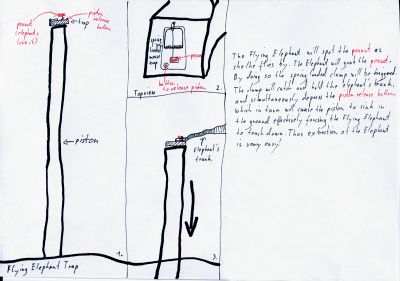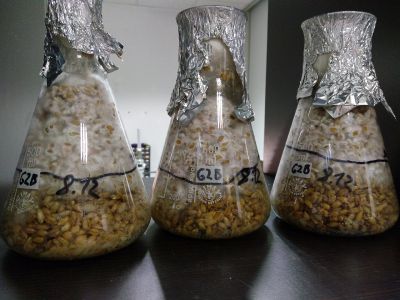Jan Glöckner (talk | contribs) No edit summary |
Jan Glöckner (talk | contribs) No edit summary |
||
| (8 intermediate revisions by the same user not shown) | |||
| Line 1: | Line 1: | ||
'''21. December''' | |||
Man kann auch ganz burleske Fälle konstruieren. Eine Katze wird in eine Stahlkammer gesperrt, zusammen mit folgender Höllenmaschine (die man gegen den direkten Zugriff der Katze sichern muß): in einem Geigerschen Zählrohr befindet sich eine winzige Menge radioaktiver Substanz, so wenig, daß im Laufe einer Stunde vielleicht eines von den Atomen zerfällt, ebenso wahrscheinlich aber auch keines; geschieht es, so spricht das Zählrohr an und betätigt über ein Relais ein Hämmerchen, das ein Kölbchen mit Blausäure zertrümmert. Hat man dieses ganze System eine Stunde lang sich selbst überlassen, so wird man sich sagen, daß die Katze noch lebt, wenn inzwischen kein Atom zerfallen ist. Der erste Atomzerfall würde sie vergiftet haben. Die Psi-Funktion des ganzen Systems würde das so zum Ausdruck bringen, daß in ihr die lebende und die tote Katze (s.v.v.) zu gleichen Teilen gemischt oder verschmiert sind. Das Typische an solchen Fällen ist, daß eine ursprünglich auf den Atombereich beschränkte Unbestimmtheit sich in grobsinnliche Unbestimmtheit umsetzt, die sich dann durch direkte Beobachtung entscheiden läßt. Das hindert uns, in so naiver Weise ein „verwaschenes Modell“ als Abbild der Wirklichkeit gelten zu lassen. An sich enthielte es nichts Unklares oder Widerspruchsvolles. Es ist ein Unterschied zwischen einer verwackelten oder unscharf eingestellten Photographie und einer Aufnahme von Wolken und Nebelschwaden. | |||
Erwin Schrödinger | |||
'''19.December''' | |||
[[File:FlyingElephantTrap.jpg|400px]] | |||
''updated literature list'' | |||
Valentin Braitenberg; Vehikel | |||
Shannon and Weaver; The mathematical theory of communication | |||
Axel Roch; Claude E. Shannon: Spielzeug, Leben und die geheime Geschichte seiner Theorie der Information | |||
Paul Stamets; The Mushroom Cultivator, Growing Gourmet and Medicinal Mushrooms, Mycelium Running | |||
Gilles Deleuze, Felix Guattari; Rhizom | |||
Niels Birbaumer, Robert F. Schmidt; Biologische Psychologie (7.Auflage) | |||
'''15 December''' | '''15 December''' | ||
| Line 14: | Line 39: | ||
[[File:fungal-pet.jpg|400px]] | [[File:fungal-pet.jpg|400px]] | ||
after all, fungi and humans are much closer related than humans and plants! ( My fungal pet even gets warm to the touch if it feels good!) | |||
https://en.wikipedia.org/wiki/Neil_Harbisson | https://en.wikipedia.org/wiki/Neil_Harbisson | ||
Latest revision as of 02:10, 21 December 2017
21. December
Man kann auch ganz burleske Fälle konstruieren. Eine Katze wird in eine Stahlkammer gesperrt, zusammen mit folgender Höllenmaschine (die man gegen den direkten Zugriff der Katze sichern muß): in einem Geigerschen Zählrohr befindet sich eine winzige Menge radioaktiver Substanz, so wenig, daß im Laufe einer Stunde vielleicht eines von den Atomen zerfällt, ebenso wahrscheinlich aber auch keines; geschieht es, so spricht das Zählrohr an und betätigt über ein Relais ein Hämmerchen, das ein Kölbchen mit Blausäure zertrümmert. Hat man dieses ganze System eine Stunde lang sich selbst überlassen, so wird man sich sagen, daß die Katze noch lebt, wenn inzwischen kein Atom zerfallen ist. Der erste Atomzerfall würde sie vergiftet haben. Die Psi-Funktion des ganzen Systems würde das so zum Ausdruck bringen, daß in ihr die lebende und die tote Katze (s.v.v.) zu gleichen Teilen gemischt oder verschmiert sind. Das Typische an solchen Fällen ist, daß eine ursprünglich auf den Atombereich beschränkte Unbestimmtheit sich in grobsinnliche Unbestimmtheit umsetzt, die sich dann durch direkte Beobachtung entscheiden läßt. Das hindert uns, in so naiver Weise ein „verwaschenes Modell“ als Abbild der Wirklichkeit gelten zu lassen. An sich enthielte es nichts Unklares oder Widerspruchsvolles. Es ist ein Unterschied zwischen einer verwackelten oder unscharf eingestellten Photographie und einer Aufnahme von Wolken und Nebelschwaden.
Erwin Schrödinger
19.December
updated literature list
Valentin Braitenberg; Vehikel
Shannon and Weaver; The mathematical theory of communication
Axel Roch; Claude E. Shannon: Spielzeug, Leben und die geheime Geschichte seiner Theorie der Information
Paul Stamets; The Mushroom Cultivator, Growing Gourmet and Medicinal Mushrooms, Mycelium Running
Gilles Deleuze, Felix Guattari; Rhizom
Niels Birbaumer, Robert F. Schmidt; Biologische Psychologie (7.Auflage)
15 December
I am getting somewhere, the feeling of being trapped is often projected, by humans, who are not trapped, onto other organisms whom we perceive as being trapped. If you observe a mouse and bait, that is put into a trap, the mouse goes through lengh of closely observing the trap, before it finally enters it. Niels Birbaumer states after his self-experiment with curare (a poison that rendered him completely paralized) that the feeling is actually not as horrible as one non-paralized being might imagine it, indeed quite pleasant, and after interviewing ALS patients he found out that they are not in despair but consider themselves happy. They are just sorry that they cannot communicate. So being trapped is clearly a matter of perspective...
What if gave a fungi the ability to communicate with humans? Well of course, one who understands the language of mushrooms knows how to communicate with them. But still... Maybe that is just the first step. Hooking up one network with another network.
Or what about giving a fungi the ability to cater to his own needs in a human environment? The aid to colonize a new realm and the ability to communicate with human to engage in mutual myco-human-relationship outside of laboratories or commercial grow farms? Living together in a shared habitat, like we already do with houseplants! Fungi-pets! After all we started out with animals and plants as productive livestock and then we made them our companions. Level up for fungi!
Here is a picture of my fungal-pet that I am pretty fond of:
after all, fungi and humans are much closer related than humans and plants! ( My fungal pet even gets warm to the touch if it feels good!)
https://en.wikipedia.org/wiki/Neil_Harbisson
http://timms.uni-tuebingen.de/Search/_QueryControl?InputQueryString=Birbaumer%2c+Niels
update 13.December:
After looking deeper into traps and traditional and contemporary trapping practices two distinct strands of thinking develop:
1.As humans we are now in advantage of nearly all other organisms we share our planet with, (save very dangerous germs and viruses I am not willing to work with), so it seems to easy to me to trap other species. 1a. It might be interesting to trap other humans, as they are more of a match. Of course this is complicated matter as I am a human too. Further investigation is needed. 1b. It might be more interesting to design a trap, that will let through all known species and will therefore be abled to trap only unknown species! supplementary: Habitats are also very important to study! Only the hunter who knows the needs and dwellings of her/his prey will be succesful in trapping.
2. Trapping involves secrecy and untruth. Even worse: it employs fraudulent misrepresentation to actively trick organisms!
I as an artist are not willing to employ such cultural techniques. Therefore I direct my actions against such intents and will develop techniques of possible counteractive measures.
About traps:
A trap is a device. A camera is a device, too. What do they have in common? Both devices are designed to capture. What is the difference between a trap and a camera? A camera captures the imprint of something or somebody, thus creating a sign. If I take a picture of a me, that picture is not me, of course, it might not even resemble me, but it carries the meaning: me. To make it even more complicated: it captures the meaning of me in a certain moment. So the camera actually captures that moment, and me, maybe by accident. I could be only by-catch. The important thing is: the camera is a device that captures moments, and turns it into signs. Signs must be meaningful to those who look at them. They must be embedded in a cultural area to be meaningful. People must be able to read the sign correctly, in order to grasp its meaning. In simple words: if a picture does not resonate with a person, if there is to connection between the picture and the person, simply nothing is happening. A trap in contrast is a device that get`s very strongly in contact with a person, as it is designed to capture persons. Which is does, it captures people physically, in that very moment. Of course, the trap can be a sign too. But if one cannot read that sign, one is still trapped, right?
Traps are devices that are to be dealt with. Once you are trapped, and before that, to avoid capture. Traps are not a proposal, like for instance a photograph can be.
At full lenght: traps aren`t nice.
Then why should I design traps? Because I am evil? Not necessarily! A trap is simpy a very strong device. It takes what it wants. And keeps it.
The art is not the artist. The artist is not the art. The art is first inside the artist, and the artist has to get it out of him/herself to encounter it. At that moment the art is already an entity.
Next: I will design small and simple traps to experiment with.
further reading:
https://youtu.be/Q6eSfKeJ_VM , http://www.altx.com/vizarts/conceptual.html http://www.strandbeest.com/ https://www.bpb.de/lernen/projekte/146368/abraham-ein-versuch
recommendations:
https://www.amazon.de/Claude-Shannon-Spielzeug-Geschichte-Information/dp/398131560X http://www.newmedia-art.org/cgi-bin/show-oeu.asp?ID=150000000034428&lg=GBR , https://vimeo.com/5496107 http://www.ericlanz.net/ , http://www.ericlanz.net/work.php?DOC_INST=17 http://www.anetterose.de/

